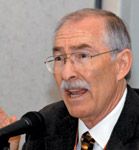Examining the role of veterinary technicians
Editor's Note: As the delivery of veterinary care becomes more sophisticated, the need to better use the skills of registered veterinary technicians increases, some veterinarians say.
Editor's Note: As the delivery of veterinary care becomes more sophisticated, the need to better use the skills of registered veterinary technicians increases, some veterinarians say.
Enhancing the technicians' role might relieve time pressure for doctors and keep them engaged in the field, but there are limits. At this year's DVM Newsmaker Summit at CVC East in Baltimore, DVM Newsmagazine assembled a panel of leaders from state boards of veterinary medicine and technician associations to examine key issues on the subject. This is the second of three segments of that roundtable; the final part will be presented in our September issue.
THE PANELISTS
Moderator: Greg Dennis, JD, of Kent T. Perry & Co. in Overland Park, Kan., is a charter member and former president of the American Veterinary Medical Law Association and served on AVMA's Model Veterinary Practice Act Task Force and the Legal Status of Animals Task Force. He co-edits the Animal Legal Report Services.

Greg Dennis, JD, panel moderator
Sue Geranen is executive officer of the California Veterinary Medical Board, a consumer watchdog agency that regulates the development and maintenance of professional standards, oversees licensing of veterinarians and registered veterinary technicians and helps enforce the California Veterinary Medicine Practice Act.
Dr. Richard Johnson owns the Animal Medical Center (AMC) of East County, a 16-doctor practice in El Cajon, Calif. A 1977 graduate of UC-Davis, he chairs the RVTC commission of the California Veterinary Medical Board. He previously was a surgical resident at the AMC and was an associate professor at the University of Illinois.
Dr. Sherbyn Ostrich is past president of the American Veterinary Medical Association and the Pennsylvania Veterinary Medical Association. A private practitioner for 30 years, he was the first recipient of the University of Pennsylvania's Bellwether Award for leadership. He is a charter member of the National Commission on Veterinary Economic Issues.
Teri Raffel, CVT, is president of the National Association of Veterinary Technicians in America. She teaches veterinary technology at the Madison Area Technical College in Madison, Wis.
Deb Coleman is an RVT. She serves on the board of regents for the Academy of Veterinary Technician Anesthetists and is employed at the Iowa State University College of Veterinary Medicine.

Dr. Richard Johnson, owner, Animal Medical Center of East County, El Cajon, Calif.
Mr. Dennis: Is "veterinary technician" the appropriate term? In other common-law countries, such as Britain and Australia, people who have gone through the equivalent of training, being registered and certified, are called "veterinary nurses." Should we be doing the same? That makes it easier for the client and the public to realize what a veterinary technician is.
Dr. Ostrich: In Pennsylvania, when the veterinary technicians association tried to get the practice-act changed to read "veterinary nurses," human nurses came into the board hearings in large numbers arguing that they absolutely, positively did not want that to happen. Of course, in any large group, no politician is going to go against them. That was the end of that in Pennsylvania.
Dr. Johnson: With the public, and I'm talking about the consumer, part of the problem is that nobody knows who you are. The veterinarians are saying, "This is my nurse, this is my assistant, this is my technician." They don't know whether you're trained or not. In California, you could be a veterinary assistant working next to a technician, and they wouldn't know the difference. The public is going to help generate at least some interest in the profession. We've got two board members who were shocked that their veterinarians didn't have licensed technicians in their practice. They just had assistants. The only term we have is "nurse." People do know what a veterinary nurse would be. We've looked at it and the CVMA looked at it. Their legal opinion was that we could not use the term. I don't understand how you can say that somebody owns the word.

Teri Raffel, CVT, president, National Association of Veterinary Technicians in America
Mr. Dennis: Let's move to an area related to this: supervision. This changes dramatically across the country. Some states are highly detailed in what scope of supervision a veterinarian must exercise over a veterinary technician, even over lay employees. How about direct supervision versus indirect supervision? Some states refer to immediate supervision, some refer to intermediate supervision.
I practice law in two states – Missouri and Kansas. To give an example of the difference: In Missouri, we have detailed regulations that tell what's permitted and what's not permitted. In Kansas, we have a statute in the veterinary-practice act that says the board has authority to promulgate regulatory actions on the supervision of veterinary technicians. But there are no regulations. So in Kansas no one knows what is permissible and not permissible conduct until disciplinary action is brought.
A classic example of a disciplinary case where a veterinarian was sanctioned is where he or she permitted a veterinary technician to perform surgery. That, at the minimum, from what I've seen in disciplinary cases, results in at least suspension, sometimes revocation of licensure. Other cases involve X-rays, and administration and dispensing of medications. I'd like to open up discussion of dispensing or administration of medications and what type of supervision a veterinarian should exercise, or whether he or she should have to supervise that.
Ms. Raffel: What is really important to remember when we talk about supervision is that veterinarians shouldn't be delegating anything they don't feel comfortable having their technician do. On the reverse side, technicians need to be comfortable saying, "I would love to learn how to do that, but I'm just not comfortable. However, I saw a notice for a meeting. Will you send me?"
I do think that, with the ever-expanding list that we get from the AVMA regarding the skills that our graduates need, there is a gradual decrease in level of supervision from graduation as you progress through the profession. But new graduates may need a little more handholding. That's true in any profession. There's always that learning curve. We have to gain stability and confidence in our profession and in our career. That doesn't mean it stays that way after you're an 18-year veteran. There has to be some kind of compromise growing with this level of supervision.

Dr. Sherbyn Ostrich, DVM, past president of AVMA
There are things we all agree as technicians we shouldn't do. That's why we're technicians. If we wanted to do surgery, we'd be veterinarians. But there's no reason I should be restricted from doing tasks allowed by AVMA.
Another issue that is important to remember is that, in interviewing, we talk about retaining people who are unfit technicians.
But the interview process has to be really important, too. People are hiring technicians without a working interview. Whether you're a new graduate or a veteran a working interview is a really important thing.
A lot of this comes back to each of us understanding our role on the team and being responsible for it. How do we educate veterinarians? How do we educate technicians? How do we educate the public?
Dr. Johnson: Physicians' assistants in California have a formal agreement that goes in their files, called delegation-of-services agreements. It says that I, as an MD, won't give you a job path that I don't think you're competent in doing. And you won't accept any job path that you don't feel comfortable and trained to do.
I would love to see something similar developed in the veterinary profession.
Dr. Ostrich: There are other implications. For example, in large-animal practice in Pennsylvania, we'll go out and bleed a herd of cows to test for brucellosis. It's the person's job to bleed the cows, identify them and not mix up the samples. It's a complicated procedure in a lot of ways.
One of the highest-paid malpractice lawsuits recorded was on a herd of cows where a brucellosis sample got mixed up. In this case, the farmer bled the cow and gave it to the veterinarian, who then shipped it to the lab. It came back negative, but the cow actually was positive. Obviously, the farmer was the culprit here. He bled the wrong bull, whether purposely or not. The bull consequently went to Texas or Florida, and it did have brucellosis. It infected not only the herd he brought it to, but also the next-door neighbor's herd, etc.
These can be highly legal, highly expensive matters when you're dealing with such regulatory work. On the other hand, if your technician is licensed, has worked with you for a while and you really feel that technician has competence, consider the following:
In an emergency situation, the technician is in the hospital but the doctor's out to lunch. The technician feels competent putting an IV into that animal, and getting it started on fluids without any supervision, because the doctor's not there. But the dog dies. Was that an illegal thing that she or he did?
I don't see how a judge would define it that way, but technically it may have been illegal. Is that right for the profession or the animals they treat? I don't think so.
Mr. Dennis: Some states have included a regulation or, in the practice act, an emergency exception to address that. But in the absence of such a provision, it would be an illegal, unlawful act of veterinary medicine. Practice acts and regulations would have to carve out emergency exceptions.
Dr. Johnson: Something the RN who works for me is teaching me is that they've been through all these steps on the human side. One thing they have developed that we're just starting to develop is protocol. So if I'm not immediately in the room and an emergency comes in, the technician is given permission in our practice to start an IV line, to start fluids, to do some basic care. If the technicians can't find me, there is a specific protocol set up to tell them this is how far they can go. They've found over time that they can expand these protocols and give more opportunities for the nurses to take care of some of these emergencies.
Ms. Coleman: The key is developing the protocol. You have to have somebody in the practice. If you have an administrator or practice manager whose role is to handle those issues, then absolutely there's no excuse. But if you have a smaller practice with maybe three veterinarians and two technicians, then it's one more thing for the technicians to do. That doesn't mean it shouldn't get done. It means the technicians need to say, "I've written this up, because we've come across this a couple of times. What do you think?" The key is getting it written. As long as people have it presented to them, most would be willing to go along with it. But letting people know that they can write it down is a big key.
Dr. Ostrich: I'll never forget back in the late 1980s the paranoia that existed. There were a lot of veterinarians who were afraid to give technicians too much responsibility. Veterinarians felt they would lose the profession. There was at least an hour debate on the House floor of the AVMA as to whether we were going to allow the name to be officially changed to "veterinary-health technician" or whether it must stay "animal technician." People from New York at that time were adamant that the word "veterinary" should not be put in front of technician, because they were afraid it might affect their ability to do things. Common sense won out finally, and we did get the ability to use veterinary technician, which we supported, but it took a long time.
Dr. Johnson: Out of 16 doctors in a practice I have, I have three doctors who are willing to do a triage where I actually have my technicians come into the room and they'll bring the animal straight back. It just saves me a lot of time. Then they can help me work up the case. Then I talk to the client. But, like Dr. Ostrich said, most of my doctors are not willing to do that. They feel they have to go in because that's the way it's always been done.
Ms. Raffel: So much that has to happen has to come from the regulatory end. The VMAs can discuss with the exam boards and promote, endorse and cajole them as much as they can into changing the rules, but unless the exam boards do it, we're kind of stuck. As someone who's been before our exam board for more years than I'm going to admit, it takes forever to get them to understand why this is not something that makes sense. It goes along with the legal part of the discussion. Are we keeping up with the way the role is changing? A lot of the state laws and rules and administrative codes were written when our profession was started or when it was recognized for the first time in that state legally. We've done some rewriting. Quite frankly, we've got people on the exam boards who are mostly veterinarians — they don't want to work that hard.
Mr. Dennis: Following up on that point, many of the state practice acts have been extensively modified over the years, but the genesis of most states' veterinary-practice acts is the AVMA's Model Veterinary Practice Act. We've amended it over the years, modified it, taken things out, but the definition of the practice of veterinary medicine remains the same.
Ms. Geranen: There is another model that states are using now — the one that was developed by the American Association of Veterinary State Boards (AAVSB), which is the regulatory entity for licensing jurisdiction in the United States, Canada and the territories. We have an annual conference. NAVTA recently started meeting with us, which is great, because that increases the dialogue between the national veterinary technician association and the regulators, the administrators. It helps us, as part of the California Veterinary Medical Board, the licensing board, to hear the issues directly. As for us, we use the AAVSB model, not the AVMA's model.
All professions started with the association. It's just an evolution that we are now moving away from the national associations and into more of a regulatory forum. But we still need the input, the interaction, because 90 percent of what licensing boards do are things we have to do in collaboration with the profession.
Technicians are pretty highly regulated in California. RVTs can be disciplined separately. When you have registered veterinary technicians, one of the purposes is so that the veterinarian isn't always the responsible one. If the veterinarian is delegating appropriately, then we have disciplined veterinary technicians independent of the veterinarian. When you have unregistered assistants in the practice and something goes wrong, it goes directly back to discipline against the veterinarian's license for a variety of causes or violations.
Defining the tasks and getting consistency of terminology are important issues. Right now we have technicians. We have three different designations across the United States. We have licensed, certified and registered. I think we're moving toward one designation. It needs to be a term that is not commingled in a veterinary hospital – "veterinary technician" means that they're registered, licensed.
Mr. Dennis: Let's switch to treatment options. Do you veterinarians discuss them with clients or do you permit your technician to do so?
Dr. Ostrich: When raccoon rabies started to move out of Virginia into Pennsylvania, it became obvious that we should be vaccinating every dog and cat. Eventually it went to the legislature, and there was a new rabies-vaccination law. The end result was this: There have been dog groups vaccinating on their own, as well as farmers doing so. So the legislature came up with this little quirk: You can be trained by your veterinarian to give a rabies shot. Then you could continue to vaccinate your own dogs for rabies. However, once that dog leaves the property, it is not officially vaccinated. It has to be revaccinated through quarantine.
Then the cat situation came up. How are we going to get people to vaccinate cats? The law in Pennsylvania now reads that any cat that spends any part of a 24-hour day inside the residence of a person has to be vaccinated. This leaves all the farm cats out of the picture. They're the ones on the front lines. In Pennsylvania right now, the No. 1 domestic animal for rabies is the cat. The legislatures and politicians can really mess up a law on what you can and can't do.
Mr. Dennis: Something I've mentioned regarding disciplinary actions involving veterinarians and veterinary technicians is surgery. Veterinary technicians are prohibited from performing surgery. Most states define surgery as any invasive procedure. Making an incision is surgery, in most states. However, there's been a bit of a change in California. This state seems to be a barometer as to what's coming across the country.
Dr. Johnson: It's a good example. We've been "battling" for two years, because we felt an RVT task would be placement of a jugular catheter. With the new materials ... you have to make an incision in the skin. That was the original proposal. Specific to placement of a jugular catheter, our technicians could make a nick incision. We argued for 2.5 hours with the California VMA on whether that was surgery. Two years later, that regulation will go into effect by calling it a relief hole. I can't tell you what a relief hole is. That's what they're going to be able to do. ... Our technicians will now be able to make a relief hole (nick incision).
Ms. Geranen: Originally, there were pages and pages – a laundry list — of tasks for RVTs. We had immediate supervision, direct and indirect. It was pretty much unworkable. Nobody could tell what anybody was supposed to do. We eliminated the immediate direct and indirect language in 1982 or 1983. Our RVT committee was made up of governor appointees. There was a California RVT association in the 1980s that never went anywhere. In the 1990s, there was no appointment to the committee. Basically there wasn't anything happening in the RVT profession on a regulatory level. Then we went through sunset review. The committee was "sunsetted" as a separate government appointee committee. It became an advisory committee to the board, with the board making appointments. In 1998, we had our first full committee in 20 years. So they got very active. During the first meeting of the RVT committee in California, they wanted to look at job tasks, authority, requiring name badges for hospitals that show name and title – who's registered, who isn't. There was a whole rash of issues. This is an emerging profession. It's something we need to address with the association, regulators, with different states like Texas. This is all consumer-driven. They are asking for more services, higher-level services, we're being told there's a shortage of veterinarians. There's a critical need for more staff, more RVTs, which is one of the items driving the grandfather clause, along with increasing educational opportunities for registration as a veterinary technician.